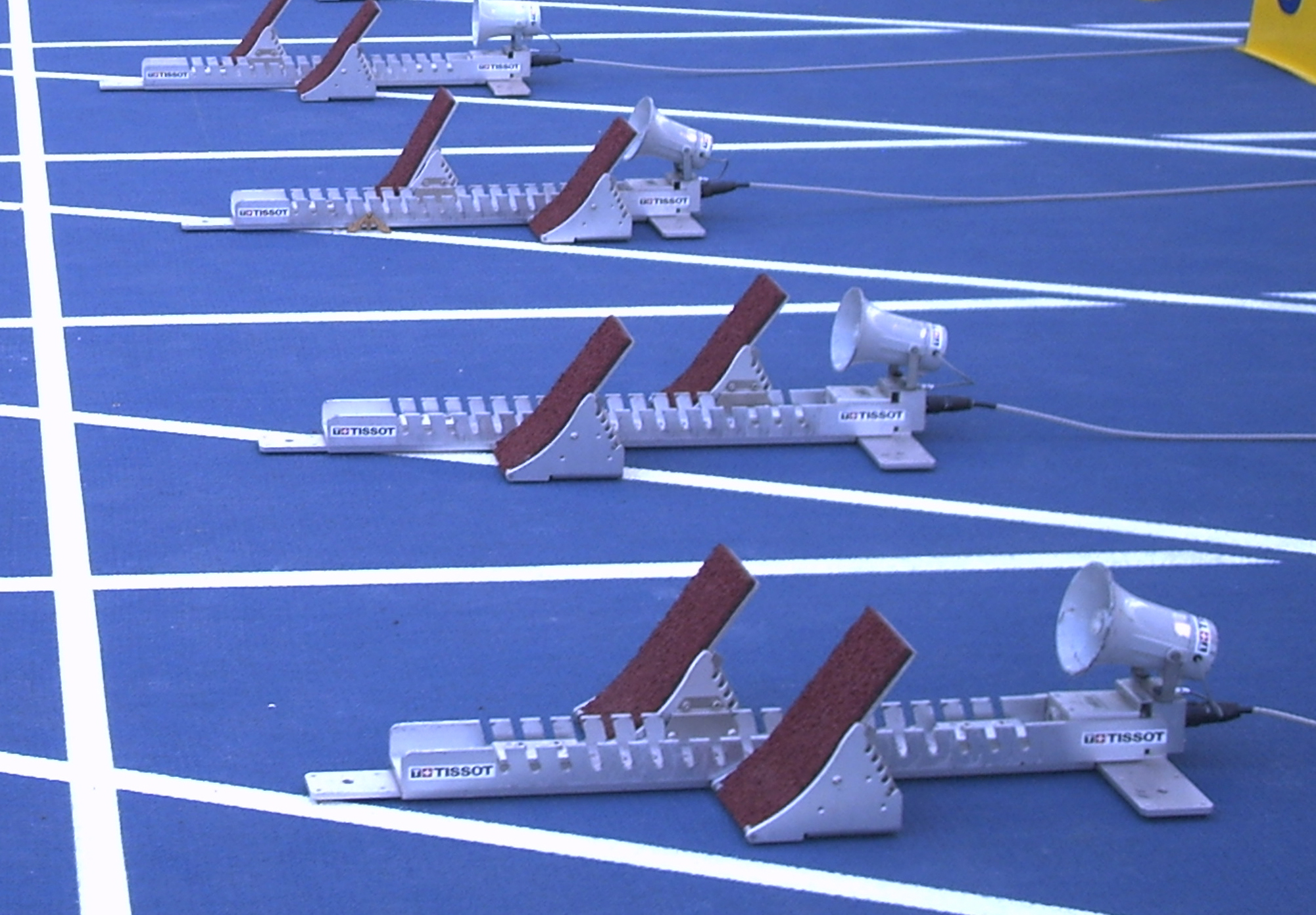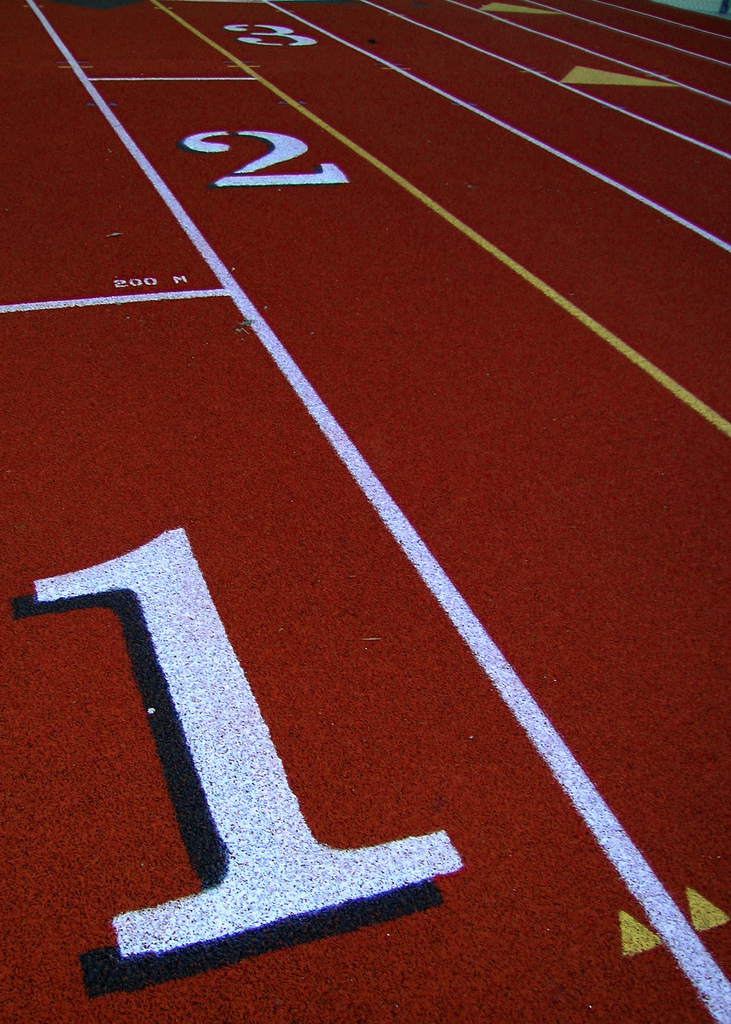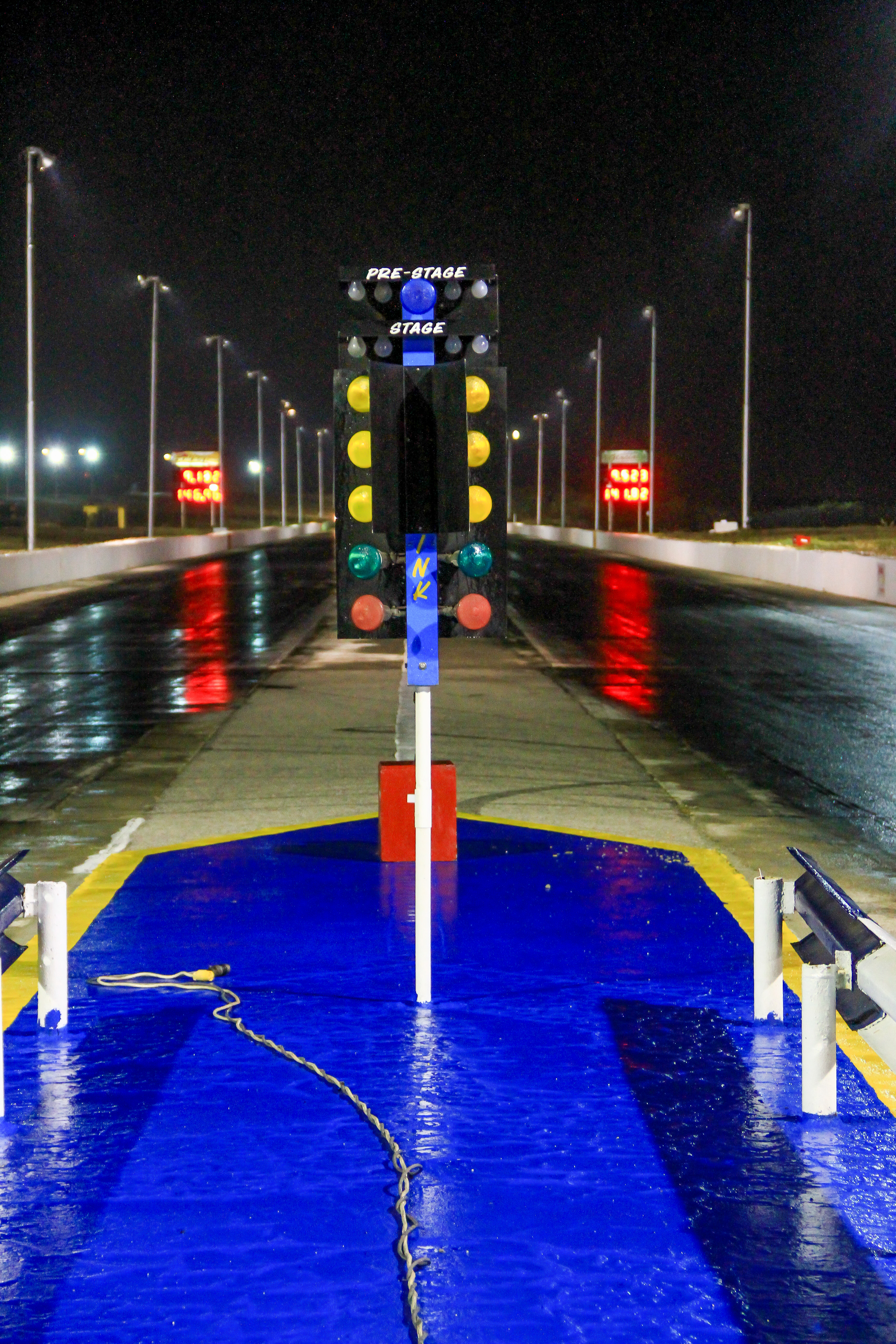|
Starting Blocks
Starting blocks are a device used in the sport of track and field by sprint athletes to brace their feet against at the start of a race so they do not slip as they stride forward at the sound of the starter's pistol. The blocks also enable the sprinters to adopt a more efficient starting posture and isometrically preload their muscles in an enhanced manner. This allows them to start more powerfully and increases their overall sprint speed capability. For most levels of competition, including the whole of high-level international competition, starting blocks are mandatory equipment for the start of sprint races. IAAF Rule 161 Their invention is credited to Australian Charlie Booth and his father in 1929. Prior to this, runners would dig holes in the dirt track. Trowels were provided at the start of races. This was not the most consistent or stable system. It also was destructive to the track surface with the holes having to be filled for subsequent runners. When George Simpson b ... [...More Info...] [...Related Items...] OR: [Wikipedia] [Google] [Baidu] |
All-weather Running Track
An all-weather running track is a rubberized, artificial running surface for track and field athletics. It provides a consistent surface for competitors to test their athletic ability unencumbered by adverse weather conditions. Historically, various forms of dirt, Rocks, sand, and crushed cinders were used. Many examples of these varieties of track still exist worldwide. Surfaces Starting in the late 1950s, artificial surfaces using a combination of rubber and asphalt began to appear. An artificial warm-up track was constructed for the 1956 Summer Olympics in Melbourne, Australia. During the 1960s many of these tracks were constructed; examples still exist today. In the mid-1960s Tartan tracks were developed, surfaced with a product by 3M. The name ''Tartan'' is a trademark, but it is sometimes used as a genericized trademark. This process was the first to commercialize a polyurethane surface for running tracks, though it was originally conceived for horse racing. Many Ta ... [...More Info...] [...Related Items...] OR: [Wikipedia] [Google] [Baidu] |
Sport Of Athletics Terminology
Sport pertains to any form of competitive physical activity or game that aims to use, maintain, or improve physical ability and skills while providing enjoyment to participants and, in some cases, entertainment to spectators. Sports can, through casual or organized participation, improve participants' physical health. Hundreds of sports exist, from those between single contestants, through to those with hundreds of simultaneous participants, either in teams or competing as individuals. In certain sports such as racing, many contestants may compete, simultaneously or consecutively, with one winner; in others, the contest (a ''match'') is between two sides, each attempting to exceed the other. Some sports allow a "tie" or "draw", in which there is no single winner; others provide tie-breaking methods to ensure one winner and one loser. A number of contests may be arranged in a tournament producing a champion. Many sports leagues make an annual champion by arranging games in a ... [...More Info...] [...Related Items...] OR: [Wikipedia] [Google] [Baidu] |
Christmas Tree (drag Racing)
Modern drag races are started electronically by a system known as a Christmas tree. A common Christmas tree consists of a column of seven lights for each driver or lane, as well as a set of light beams across the track itself. Each side of the column of lights is the same; from the top down, there are a blue LED light set, then three amber bulbs, then a green bulb and a red bulb. The light beams are arranged with one set on the starting line, and another set 7 inches behind it. When drivers are preparing to race, they first cross the beams 7 inches behind the starting line. Crossing this beam activates the top bulbs. At this point, with most modern starting lights, the tree is activated. Once pre-staged, drivers roll up 7 inches and cross the second beam on the starting line, bottom bulbs, Once the first driver activates the bottom bulbs, the subsequent drivers have seven seconds or they are timed out and automatically disqualified, even in qualifying (a red-light foul is ignor ... [...More Info...] [...Related Items...] OR: [Wikipedia] [Google] [Baidu] |
Athletics At The 1956 Summer Olympics – Men's 800 Metres
The men's 800 metres event at the 1956 Summer Olympics in Melbourne was held on 23, 24, and 26 November 1956. There were a total number of 38 competitors from 24 nations. The maximum number of athletes per nation had been set at 3 since the 1930 Olympic Congress. The event was won by Tom Courtney, the last of a streak of four American victories in the event and the seventh overall United States victory. Derek Johnson (athlete), Derek Johnson's silver put Great Britain back on the podium for the first time since that nation's own four-Games gold streak ended in 1932. Norway received its first men's 800 metres medal with Audun Boysen's bronze. Summary This one Olympiad saw the use of starting blocks from a waterfall start for the 800 meters. All subsequent races have used a standing start in lanes, breaking after the first turn (known as a one turn stagger). Out of the blocks, Tom Courtney got the edge around the turn, but by the end of the turn Arnie Sowell edged into the lead ... [...More Info...] [...Related Items...] OR: [Wikipedia] [Google] [Baidu] |
400 Meters
The 400 metres, or 400-meter dash, is a sprint event in track and field competitions. It has been featured in the athletics programme at the Summer Olympics since 1896 for men and since 1964 for women. On a standard outdoor running track, it is one lap around the track. Runners start in staggered positions and race in separate lanes for the entire course. In many countries, athletes previously competed in the 440-yard dash (402.336 m)—which is a quarter of a mile and was referred to as the 'quarter-mile'—instead of the 400 m (437.445 yards), though this distance is now obsolete. Like other sprint disciplines, the 400 m involves the use of starting blocks. The runners take up position in the blocks on the 'ready' command, adopt a more efficient starting posture which isometrically preloads their muscles on the 'set' command, and stride forwards from the blocks upon hearing the starter's pistol. The blocks allow the runners to begin more powerfully and the ... [...More Info...] [...Related Items...] OR: [Wikipedia] [Google] [Baidu] |
False Start
In sports, a false start is a disallowed start, usually due to a movement by a participant before (or in some cases after) being signaled or otherwise permitted by the rules to start. Depending on the sport and the event, a false start can result in a penalty against the athlete's or team's field position, a warning that a subsequent false start will result in disqualification, or immediate disqualification of the athlete from further competition. False starts are common in racing sports (such as swimming, track, sprinting, and motor sports), where differences are made by fractions of a second and where anxiety to get the best start plays a role in the athletes' behavior. A race that is started without a false start is referred to as a ''fair start'' or ''clean start''. In sports Association Football (soccer) Football games cannot be restarted unless certain conditions are met. For example, both teams need to be in their own half of the field for the start of the game or re ... [...More Info...] [...Related Items...] OR: [Wikipedia] [Google] [Baidu] |
Tartan Track
Tartan Track is a trademarked all-weather synthetic track surfacing made of polyurethane used for track and field competitions, manufactured by 3M. It lets athletes compete in bad weather without serious performance loss and improves their results over other surfaces. It also provides a more consistent surface for competition even under optimum weather. Such tracks have become the standard for most elite competitions. Because the "Tartan" brand name was the first and was widely successful in its time, the name Tartan has been used as a genericized trademark for description of an all-weather running track. History The 1968 Summer Olympics at Mexico City was the first Olympic Games to use the Tartan track surface in athletics. Olympic shot put champion Bill Nieder and American record holder in the mile Don Bowden were instrumental in developing the product and selling it for use in the 1968 Olympics. American track and field coach Bert Bonanno, who had been recruited by t ... [...More Info...] [...Related Items...] OR: [Wikipedia] [Google] [Baidu] |
Nick Newton
Milton "Nick" Newton (born November 6, 1933 in Tarboro, North Carolina, United States – March 31, 2018 in Palm Springs, California) was the inventor of the Newton Starting Blocks. Newton blocks are considered by many to be the best in the world, used at many major track meets like the Mt. SAC Relays. Starting blocks are the device sprinters use to hold their feet at the start of a race so they do not slip as they push out at the sound of the gun. Using his experience as a tool and die maker for Waste King, Newton invented a cast aluminum block design as an improvement for his daughter Pam, who was excelling in girls' track. Newton's solid, but lightweight versions greatly improved on the flimsy or rusty old devices that had been standard equipment for decades. Obtaining his first patent in 1978 Newton has subsequently patented two additional innovations to offer sprinters more possible settings to prepare for their start. He became heavily involved as a mentor for the L.A. M ... [...More Info...] [...Related Items...] OR: [Wikipedia] [Google] [Baidu] |
Track And Field
Track and field is a sport that includes athletic contests based on running, jumping, and throwing skills. The name is derived from where the sport takes place, a running track and a grass field for the throwing and some of the jumping events. Track and field is categorized under the umbrella sport of athletics, which also includes road running, cross country running and racewalking. The foot racing events, which include sprints, middle- and long-distance events, racewalking, and hurdling, are won by the athlete who completes it in the least time. The jumping and throwing events are won by those who achieve the greatest distance or height. Regular jumping events include long jump, triple jump, high jump, and pole vault, while the most common throwing events are shot put, javelin, discus, and hammer. There are also "combined events" or "multi events", such as the pentathlon consisting of five events, heptathlon consisting of seven events, and decathlon cons ... [...More Info...] [...Related Items...] OR: [Wikipedia] [Google] [Baidu] |
100-yard Dash
1 (one, unit, unity) is a number representing a single or the only entity. 1 is also a numerical digit and represents a single unit of counting or measurement. For example, a line segment of ''unit length'' is a line segment of length 1. In conventions of sign where zero is considered neither positive nor negative, 1 is the first and smallest positive integer. It is also sometimes considered the first of the infinite sequence of natural numbers, followed by 2, although by other definitions 1 is the second natural number, following 0. The fundamental mathematical property of 1 is to be a multiplicative identity, meaning that any number multiplied by 1 equals the same number. Most if not all properties of 1 can be deduced from this. In advanced mathematics, a multiplicative identity is often denoted 1, even if it is not a number. 1 is by convention not considered a prime number; this was not universally accepted until the mid-20th century. Additionally ... [...More Info...] [...Related Items...] OR: [Wikipedia] [Google] [Baidu] |
George Simpson (sprinter)
George Sidney Simpson (September 21, 1908 – December 2, 1961) was an American sprinter. He competed at the 1932 Olympics and won a silver medal in the 200 m, placing fourth in the 100 m event. Simpson was the first to run 100 yards in 9.4 seconds, but because he used starting blocks, the record was never ratified. He won the in both NCAA The National Collegiate Athletic Association (NCAA) is a nonprofit organization that regulates student athletics among about 1,100 schools in the United States, Canada, and Puerto Rico. It also organizes the athletic programs of colleges ... and AAU in 1930. He was also fourth in the 100 meters at the 1932 Olympics. In 1929 he unofficially equaled the 200 meters World Record 20.6 seconds. Simpson attended Ohio State and won a national title in 1929. Competition record References 1908 births 1961 deaths Ohio State University alumni Ohio State Buckeyes men's track and field athletes Athletes (track and field) at the 193 ... [...More Info...] [...Related Items...] OR: [Wikipedia] [Google] [Baidu] |





